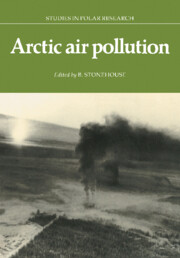Book contents
- Frontmatter
- Contents
- CONTRIBUTORS TO THIS VOLUME
- FOREWORD
- INTRODUCTION: INTERNATIONAL SYMPOSIUM ON ARCTIC AIR POLLUTION
- Part 1 Composition, source areas and transport pathways
- Part 2 Local, regional, global, ecological and climatic implications
- Part 3 Health and ecological issues
- Epidemiology of health effects of air pollution
- Biological effects of low-level ionizing and non-ionizing radiation
- Ecological processes in the cycling of radionuclides within Arctic ecosystems
- Cancer incidence and risk in Alaskan natives exposed to radioactive fallout
- Indoor air pollution and public health concerns
- Exposure to heavy metals in Greenland from natural and man-made sources
- Ecological implications of arctic air pollution
- Part 4 International cooperation and state responsibility
- 5 Conclusions
- Index
Cancer incidence and risk in Alaskan natives exposed to radioactive fallout
Published online by Cambridge University Press: 03 May 2010
- Frontmatter
- Contents
- CONTRIBUTORS TO THIS VOLUME
- FOREWORD
- INTRODUCTION: INTERNATIONAL SYMPOSIUM ON ARCTIC AIR POLLUTION
- Part 1 Composition, source areas and transport pathways
- Part 2 Local, regional, global, ecological and climatic implications
- Part 3 Health and ecological issues
- Epidemiology of health effects of air pollution
- Biological effects of low-level ionizing and non-ionizing radiation
- Ecological processes in the cycling of radionuclides within Arctic ecosystems
- Cancer incidence and risk in Alaskan natives exposed to radioactive fallout
- Indoor air pollution and public health concerns
- Exposure to heavy metals in Greenland from natural and man-made sources
- Ecological implications of arctic air pollution
- Part 4 International cooperation and state responsibility
- 5 Conclusions
- Index
Summary
ABSTRACT. Cancer incidence in northern Alaskan villages exposed to radioactive fallout from nuclear weapons testing in the late 1950s and early 1960s was assessed using data from the Alaskan Native Tumor Registry. Previous studies have shown that cancer incidence in Alaskan natives differs from that in residents of the rest of the United States: rates of cancer of the nasopharynx and liver are higher in Alaskan native men and rates of cancer of the nasopharynx, gallbladder, cervix, and kidney are higher in Alaskan native women. Leukemia, breast cancer and bone sarcoma are the cancers most likely to result from fallout exposure in the Arctic, but the incidence of these cancers in the North Slope villages appeared to be lower than in either the entire Inuit population or the US population.
The fallout radionuclides of potential health concern are cesium–137 and strontium– 90, because of their abundance, long half-life, and chemical characteristics that facilitate transport through and concentration in the food chain and accumulaton in sensitive tissues of the body. Radionuclide body burdens were determined in North Slope Inuit 25 years ago, because of their possible exposure to radioactive fallout via the lichen-caribou-man pathway. Cancer risk estimates have been calculated using highest average dose measurements from residents of Anaktuvuk Pass, under the assumption that peak exposure levels of the mid 1960s remained steady over the following 20 years. Worst-case estimates of expected cancer excess were calculated for leukemia, breast cancer and bone sarcoma.
- Type
- Chapter
- Information
- Arctic Air Pollution , pp. 229 - 238Publisher: Cambridge University PressPrint publication year: 1987



